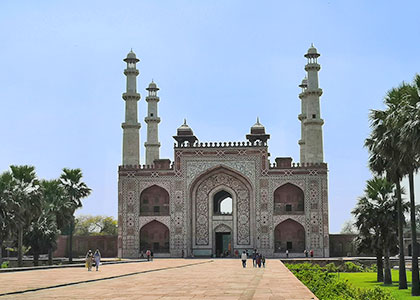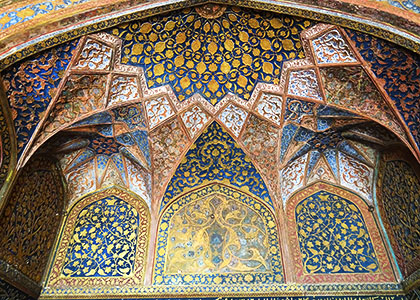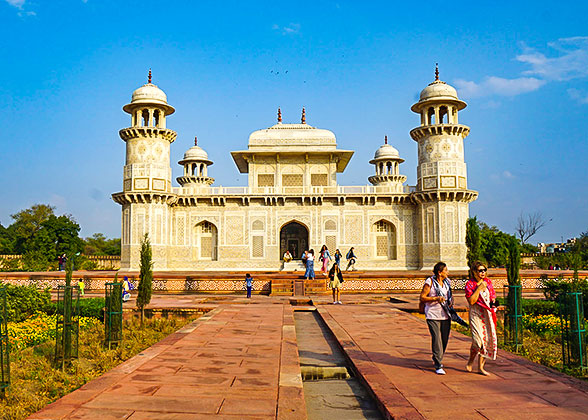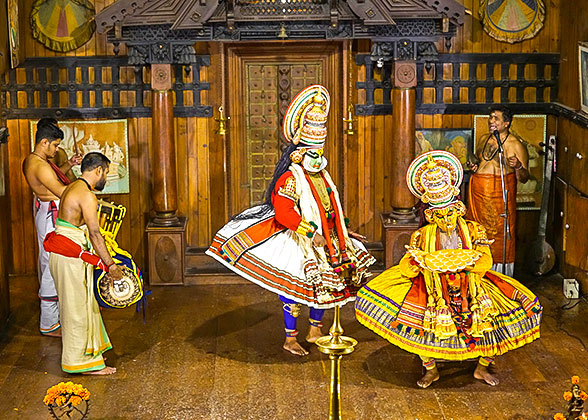Akbar’s Tomb, Agra
The Tomb of Akbar the great is one of the best architectural masterpieces of medieval times. It was built in 1605-1613. Akbar himself started the construction of this edifice which was later completed by his son Jahangir. Akbar Tomb is situated in 119 acres of grounds in Sikandra, Agra, Uttar Pradesh in India. The tomb is 14km (9mi) away from the Taj Mahal.Brief Introduction of Akbar the Great
Akbar the Great, the third emperor of the Mughal dynasty ruled India at the age of 14 when he was crowned as the Mughal ruler after the sudden death of his father, Humayun. Akbar was a good administrator and also a connoisseur of art and architecture. During his monarchy, he built numerous buildings including the great Agra Fort and the imperial city at Fatehpur Sikri. While he was alive, he supervised the construction of the tomb during his lifetime.

|
Akbar was illiterate - could neither read nor write. But this did not stop him from cultivating his knowledge, exposure, and acquaintance of the most learned poets, authors, musicians and architects of his time. The unique blend of art and culture is the signature style of buildings and monuments during the time of Akbar. The mixture of Islamic style with local Rajasthani and Gujrati styles can be found in various buildings in Fatehpur Sikri.
Though there are many claims and assumptions among the historians based on the regime and rule of the monarch, it can be seen and observed that Akbar was quite a fan of different art forms and culture as it is featured in all the monumental buildings constructed during his rule. The tomb of Akbar also houses the remains of his daughters, Shakrul Nisha Begum and Aram Bano.
Keynotes on Akbar Tomb

Akbar's Tomb
|
![]() Entrance Fee: INR 310
Entrance Fee: INR 310
![]() If foreign they purchase a toll ticket of INR 500 for visiting the Taj Mahal, they do not need to purchase a ticket for paying a visit to Akbar’s Tomb only on the same day. If you want to shoot a video, the cost of carrying a video camera is INR 25.
If foreign they purchase a toll ticket of INR 500 for visiting the Taj Mahal, they do not need to purchase a ticket for paying a visit to Akbar’s Tomb only on the same day. If you want to shoot a video, the cost of carrying a video camera is INR 25.
![]() Best Time to Visit: October to March
Best Time to Visit: October to March
![]() How to Reach:
How to Reach:
The Architecture of Akbar Tomb
Akbar Tomb Sikandra is the perfect example of the assimilation of various styles of architecture representing the culture and history of the Mughals in India. This tomb is housed in a large walled garden on the Delhi-Agra road. The arabesque embellishments with floral designs and the use of colored marbles crowned with four elegant minarets in white marble, will surely leave you awe-struck and mesmerize your senses. The beauty of the tomb is surely grand and the calligraphic decorations on the edifice are one of a kind.
Unlike any other Mughal tombs, the tomb of Akbar the Great is faced towards the east rather than facing towards Mecca. The basement where the remains of Akbar are kept is not open for tourists. It is said that it contains precious, expensive jewels and weapons.
Akbar’s tomb inculcates a vintage blend of Hindu, Christian, Islamic, Jain and Buddhist styles of architecture, an iconic mixture of the positivity of different cultures.
 Gateway for the Tomb
Gateway for the Tomb
The gateway for the tomb is the most magnificent of any monument in the country. The beautiful charbagh (four gardens) leads to this pyramidal structure of the tomb of Akbar. The mausoleum is located on the outskirts of Agra city and houses the mortal remains of the Mughal emperor. The building contains 5 storeys. The tomb is constructed of red sandstone except for the top storey that is made of marble.
|
|
|
 Ground Storey
Ground Storey
The ground storey, the central courtyard of the tomb, is enclosed by arches and piers and is divided into bays roofed in the trabeate pattern. There is a square platform at the centre of the courtyard over which the white marble cenotaph is created. The large panels of intricately crafted jali (filigree) form the outer wall of the verandah from all four sides.
 Grave of Akbar
Grave of Akbar
The grave of Akbar lies in the basement of the tomb that can be reached through a portico that is covered with stucco paintings in gold, green, and blue and have Persian inscriptions on them. Sikandra is considered as the most impeccable of all the Mughal buildings. The tomb of Akbar represents the Islamic influence amalgamating different styles and blending them into one. Rajputana and the Gothic style of architecture can also be witnessed at the tomb.The sleek, awesome and conscious attractiveness of the architecture of the premises of the tomb of Akbar truly steals the heart of anyone who visits this place. You will feel gratitude looking at the monument whatever be its ambiguous history.






